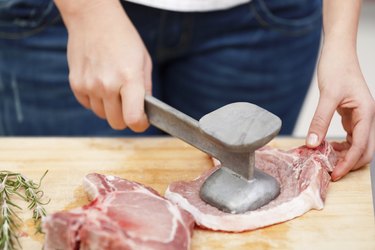
Naturally tender cuts of meat tend to be more expensive, and serving meat on a budget can be a challenge. There are many ways to tenderize tough meat before cooking it, which include pounding, scoring, soaking in a marinade and sprinkling it all over with a powdered meat tenderizer. All of these methods have the same goal in mind: Break down the dense, tough muscle fibers and the protein that binds them.
Meat Facts
Video of the Day
Meat is basically made of muscle. Each cut of meat is made up of muscle fibers bound together by protein filaments called collagen. Tenderizing meat means breaking the long strands of muscle as well as softening the collagen until it turns into gelatin. This soft gelatin soaks into the meat, tenderizing it and adding moisture to make the meat juicy. This tenderizing can be accomplished through physical means like pounding, or through the chemical reactions caused when it is exposed to the acids in marinades and powdered meat tenderizers.
Video of the Day
Tenderizer Facts
The two main ingredients in most powdered tenderizers are papain, found in papayas, and bromelain, found in pineapples. Both enzymes attack the muscle fibers and the collagen webs that holds them together. This softens the meat and makes it more tender. It is also why you cannot put raw papaya or pineapple in gelatin desserts. The papain and bromelain break down the gelatin, just as they do the collagen in meats.
Benefits
Tenderizing tough cuts of meat allows you to serve protein-rich meals on a budget. Too much red meat is not good for your cholesterol levels or your waistline, but less expensive meats also tend to be leaner. It is the marbling of fat throughout the more expensive cuts that make them naturally tender, so cooking leaner meats saves calories and fat. Tenderizing meat chemically saves time because many lean cuts require an hour or more of braising – being slow-cooked in a liquid – to break down the tough muscle fibers and gelatinize the collagen.
Warning
Many commercial meat tenderizers contain monosodium glutamate and large amounts of sodium. Monosodium glutamate, according to Columbia University's health advice service, is the most studied food additive in the United States. It has been pronounced safe for consumers by the U.S. Food and Drug Administration, but a certain portion of the population – usually those with asthma – report side effects including headaches, nausea and flushing of the neck and face. Large amounts of sodium can contribute to and exacerbate high blood pressure, so read the labels on commercial meat tenderizers before purchasing.
- Exploratorium: The Science of Meat; What Makes Meat Juicy and Tender?
- Food Republic; How Does Meat Tenderizer Work?; Jared Levan; July 2011
- Frostburg State University General Chemistry Online; Why is Papain an Effective Meat Tenderizer?; Fred Senese
- Columbia University Go Ask Alice!: What's the Deal with MonosodiColumbia University Go Ask Alice!: What's the Deal with Monosodium Glutamate (MSG)?; August 2002um Glutamate (MSG)?; August 2002
- OChef: How to Tenderize Meat